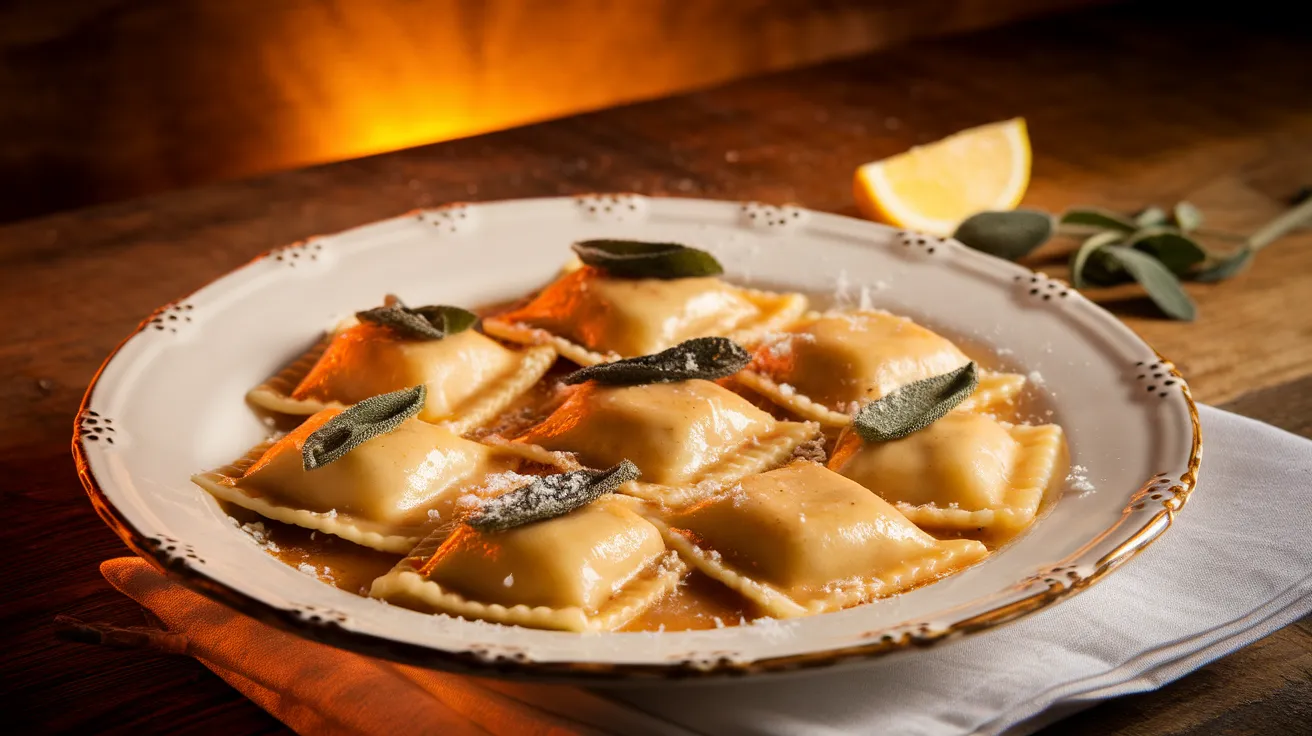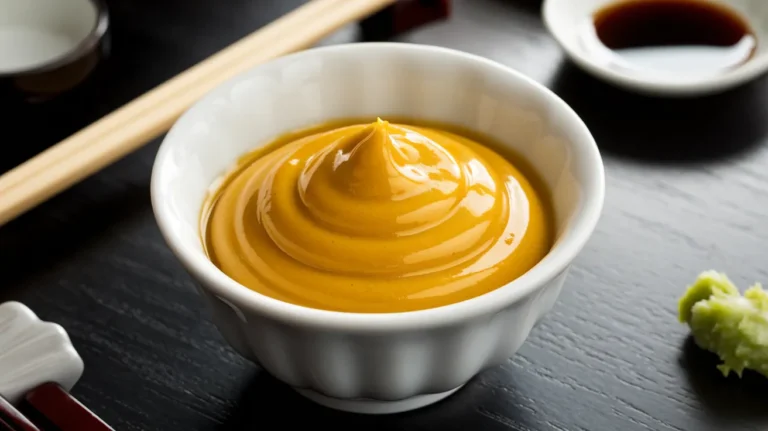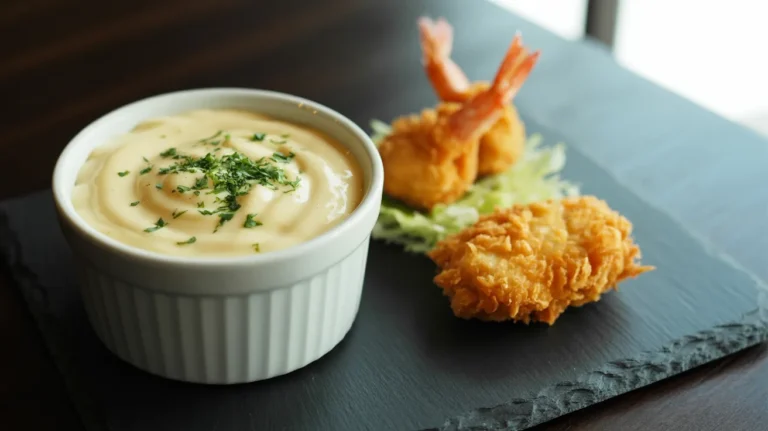This elegant sauce for lobster ravioli transforms simple ingredients into a restaurant-quality masterpiece. The rich brown butter creates a nutty foundation while fresh sage adds aromatic complexity that perfectly complements delicate lobster filling. Our foolproof sauce for lobster ravioli recipe ensures even beginners can create this luxurious dish with confidence and impressive results every time.
SERVES: 4 | PREP: 15 MIN | COOK: 12 MIN | TOTAL: 27 MIN
Essential Ingredients for Sauce for Lobster Ravioli
For the Brown Butter Sage Sauce:
| Ingredient | Amount | Purpose |
|---|---|---|
| Unsalted butter | 8 tablespoons (1 stick) | Creates rich, nutty base |
| Fresh sage leaves | 20-24 leaves | Adds aromatic depth |
| Garlic cloves, minced | 2 cloves | Provides savory foundation |
| Fresh lemon juice | 2 tablespoons | Balances richness |
| Lemon zest | 1 teaspoon | Adds bright citrus notes |
| White wine | 1/4 cup | Deglazes and adds complexity |
| Heavy cream | 3 tablespoons | Creates silky texture |
| Parmesan cheese, grated | 1/2 cup | Adds umami depth |
| Salt | 1/2 teaspoon | Enhances all flavors |
| Black pepper | 1/4 teaspoon | Adds gentle heat |
For Serving:
| Ingredient | Amount |
|---|---|
| Fresh lobster ravioli | 1 pound (20-24 pieces) |
| Extra Parmesan | For garnish |
| Fresh lemon wedges | 4 pieces |
Detailed Step-by-Step Instructions for Beginners
Phase 1: Essential Preparation (8-10 minutes)
Step 1: Prepare Your Workspace Clear a large area near your stove and lay out all ingredients. Place measuring spoons, a slotted spoon, and paper towels within easy reach. This sauce for lobster ravioli moves quickly once you start, so organization prevents mistakes.
Step 2: Start the Pasta Water Fill your largest pot (at least 6-quart capacity) with water, leaving 3 inches from the rim. Add 1 tablespoon of salt per quart of water – this seems like a lot, but it’s crucial for flavoring the ravioli from inside out. Place over high heat with the lid on to speed boiling.
Step 3: Prepare the Sage Leaves Remove sage leaves from stems and lay them on paper towels. Pat each leaf completely dry – even tiny water droplets will cause dangerous splattering when they hit hot butter. Let them air-dry for 5 minutes while you prep other ingredients.
Step 4: Prep All Aromatics Mince garlic cloves finely – they should be no larger than rice grains to prevent burning. Zest one lemon using a microplane grater (avoid the bitter white pith). Cut the zested lemon in half and juice it through a fine strainer to remove seeds. Grate Parmesan cheese fresh for best melting results.
Step 5: Set Up Your Cooking Station Place your largest skillet (preferably stainless steel or cast iron) next to the stove. Have a small bowl ready for the crispy sage and another bowl for pasta water. Open your wine and measure it out – cooking wine evaporates alcohol but leaves flavor.
Phase 2: Creating Perfect Brown Butter (6-7 minutes)
Step 6: Begin Melting the Butter Cut butter into small, uniform pieces for even melting. Place your skillet over medium heat – never high heat, which burns butter instantly. Add all butter pieces at once and let them melt without stirring initially. You’ll hear gentle sizzling.
Step 7: Monitor the Butter Transformation As butter melts completely (about 2 minutes), it will start to foam. This is normal – the foam contains milk proteins that will brown. Swirl the pan gently every 30 seconds rather than stirring, which can cause splattering.
Step 8: Identify the Brown Butter Stage Watch for three key changes: First, the foam will subside slightly. Second, you’ll smell a distinct nutty aroma like toasted hazelnuts. Third, tiny golden-brown bits will appear at the bottom of the pan. The butter should be deep amber colored – not black, which indicates burning.
Step 9: Perfect Your Timing From start to brown butter takes about 4-5 minutes total. If it’s browning too quickly, reduce heat to medium-low. If it’s taking longer than 6 minutes, increase heat slightly. The nutty smell is your best indicator – trust your nose.
Phase 3: Sage Crisping Technique (2-3 minutes)
Step 10: Add Sage at the Right Moment The moment your butter reaches perfect amber color and nutty fragrance, immediately add all sage leaves. They should sizzle vigorously – if they don’t, your butter wasn’t hot enough. Stand back slightly to avoid any minor splattering.
Step 11: Achieve Perfect Crispiness Sage leaves will crisp within 45-90 seconds. They’ll turn darker green and stop bubbling actively. Use a slotted spoon to lift each leaf, letting excess butter drain back into the pan. Don’t leave them longer – they’ll become bitter.
Step 12: Handle the Crispy Sage Transfer crispy sage to paper towels and let cool for 30 seconds. Reserve half the leaves whole for garnish and roughly chop the remaining half. The chopped sage will integrate into the sauce while whole leaves provide textural contrast.
Phase 4: Building the Flavor Base (4-5 minutes)
Step 13: Cook the Garlic Properly Add minced garlic to the brown butter and stir constantly for exactly 30 seconds. The garlic should become fragrant but not brown – browned garlic tastes bitter and will overpower the delicate lobster flavor in your ravioli.
Step 14: Deglaze with Wine Remove the pan from heat briefly and pour in white wine slowly – it will bubble vigorously and steam. Return to medium heat and let the wine reduce by half (about 2 minutes). You’ll know it’s ready when the sharp alcohol smell dissipates and the liquid looks syrupy.
Step 15: Add Citrus Elements Stir in lemon zest and fresh lemon juice. The acid will brighten the rich brown butter and help cut through the richness that pairs so well with lobster. The sauce will sizzle briefly as the citrus hits the hot pan.
Step 16: Create the Creamy Finish Add heavy cream and chopped sage back to the pan. Let the mixture simmer gently for 1 minute – you’ll see small bubbles around the edges, not a rolling boil. The sauce should thicken slightly and become glossy.
Phase 5: Cooking Ravioli to Perfection (4-5 minutes)
Step 17: Test Water Readiness Your pasta water should be at a rolling boil with large bubbles breaking the surface. Taste the water – it should be as salty as mild seawater. If it’s too salty, add a cup of fresh water. If it’s bland, add more salt.
Step 18: Cook Ravioli Gently Add lobster ravioli one by one to prevent sticking. Fresh ravioli typically cooks in 3-4 minutes, while frozen takes 5-6 minutes. They’re done when they float to the surface and feel tender when pressed gently with a spoon.
Step 19: Reserve Pasta Water Before draining, use a ladle or measuring cup to reserve 1/2 cup of the starchy pasta water. This cloudy water contains starch that helps bind your sauce for lobster ravioli to the pasta perfectly.
Step 20: Transfer with Care Using a large slotted spoon or spider strainer, lift ravioli from the water and transfer directly into the sauce. Never dump them into a colander – the sudden temperature change and rough handling can cause delicate ravioli to burst.
Phase 6: Final Assembly and Perfection (2-3 minutes)
Step 21: Create the Perfect Sauce Consistency Add 2-3 tablespoons of reserved pasta water to the pan with ravioli. The starchy water will help the sauce cling to each piece of ravioli. Gently swirl the pan rather than stirring aggressively to prevent breaking the delicate pasta.
Step 22: Incorporate Cheese Properly Remove the pan from heat and add half the grated Parmesan cheese. The residual heat will melt the cheese perfectly – adding it on direct heat can cause it to become stringy or clumpy. Toss very gently with two spoons.
Step 23: Season and Balance Flavors Taste the sauce carefully and adjust seasoning. Add salt if needed, freshly ground black pepper for warmth, or additional lemon juice if the sauce tastes too rich. The perfect sauce for lobster ravioli should be rich but bright, with all flavors in harmony.
Step 24: Final Presentation Check Each ravioli should be evenly coated with glossy sauce. If the sauce seems too thick, add warm pasta water one tablespoon at a time. If it’s too thin, let it simmer for 30 seconds to reduce slightly.
Professional Chef’s Notes for Sauce for Lobster Ravioli
Expert Tip #1: The secret to restaurant-quality sauce for lobster ravioli lies in temperature control. Keep your heat at medium throughout the entire process to prevent burning the delicate brown butter that forms the sauce foundation.
Expert Tip #2: Timing synchronization is crucial for this sauce for lobster ravioli recipe. Start browning your butter when the pasta water reaches a rolling boil – this ensures both components finish simultaneously for optimal flavor and texture.
Expert Tip #3: If your sauce breaks or appears oily, don’t panic. Remove from heat immediately and whisk in cold butter one piece at a time to re-emulsify. The sauce will become smooth and glossy again.
Expert Tip #4: Fresh sage makes an enormous difference in this sauce for lobster ravioli. Dried sage won’t crisp properly and lacks the bright, aromatic quality that makes this dish special. Always use fresh herbs when possible.
Complete Nutrition Information (Per Serving)
- Calories: 385
- Protein: 18g
- Carbohydrates: 28g
- Fat: 24g (mostly from butter and cheese)
- Fiber: 2g
- Sodium: 650mg
- Calcium: 180mg (from Parmesan)
Creative Variations for Your Sauce for Lobster Ravioli
1. Lemon-Forward Version
Create a brighter version by doubling the lemon zest and adding ricotta cheese for creaminess. This technique works beautifully and you can find similar approaches in our sauce for lemon ricotta ravioli recipe.
2. Herb-Crusted Style
Add fresh thyme and oregano alongside the sage for a more complex herbal profile. This multi-herb approach creates depth similar to techniques used in our sauce for egg noodles recipe.
3. Wine-Enhanced Version
Double the white wine to 1/2 cup and reduce it by three-quarters for a more pronounced wine flavor that complements the lobster beautifully.
4. Cream-Forward Adaptation
Increase heavy cream to 1/4 cup and add a touch of Dijon mustard for a richer, more indulgent sauce for lobster ravioli.
Storage & Reheating Your Sauce for Lobster Ravioli
Proper Refrigerator Storage:
Store leftover sauce separately from ravioli in an airtight container for up to 3 days. The brown butter will solidify when cold but will return to proper consistency when gently reheated.
Best Reheating Methods:
Stovetop Technique: Place sauce in a small saucepan over low heat. Whisk in 1-2 tablespoons of warm water or cream to restore the original silky consistency as it warms.
Microwave Method: Heat in 15-second intervals at 50% power, stirring between each interval until warm and smooth. Never use full power, which can cause the sauce to break.
Make-Ahead Strategy:
Prepare the brown butter sage base up to 2 hours in advance and keep warm in a double boiler. Add the cream and final seasonings just before serving for best results.

Troubleshooting Common Problems with Sauce for Lobster Ravioli
Issue #1: Burnt Brown Butter
Detailed Solution: Unfortunately, burnt butter cannot be saved – it develops a bitter, acrid taste. Start completely over with fresh butter, keeping heat at medium and watching more carefully. The nutty aroma should develop gradually over 4-5 minutes.
Issue #2: Sauce Too Thick or Pasty
Step-by-Step Fix: Remove from heat immediately. Add warm pasta water one tablespoon at a time while whisking constantly. The starch in the pasta water will help create the proper silky consistency for your sauce for lobster ravioli.
Issue #3: Broken or Separated Sauce
Professional Repair: This happens when the sauce gets too hot or the dairy separates. Remove from heat and whisk in cold butter one small piece at a time. The cold fat will re-emulsify the sauce back to smoothness.
Issue #4: Soggy, Non-Crispy Sage
Prevention and Fix: Ensure sage leaves are bone dry before adding to hot butter. If they’re already soggy, remove them and start with fresh, completely dry leaves. Pat with paper towels and let air-dry for 5 minutes.
Issue #5: Ravioli Breaking or Bursting
Gentle Handling Solution: Use a gentler rolling boil instead of vigorous bubbling. Handle cooked ravioli exclusively with a slotted spoon or spider strainer, never regular spoons or forks that can puncture the delicate pasta.
Essential Equipment for Perfect Sauce for Lobster Ravioli
Must-Have Tools:
- Heavy-bottomed skillet (10-12 inches, stainless steel preferred)
- Large pasta pot (minimum 6-quart capacity)
- Slotted spoon or spider strainer for safe ravioli transfer
- Fine-mesh strainer for removing sage leaves
- Microplane grater for fresh lemon zest
- Digital timer for precise cooking phases
Helpful Extras:
- Small ladle for pasta water
- Tasting spoons for seasoning adjustments
- Paper towels for drying sage leaves
- Small bowls for organizing ingredients
Complete Shopping List for Sauce for Lobster Ravioli
Dairy Section:
- Unsalted butter (1 stick minimum, buy 2 for backup)
- Heavy cream (small container – 1 pint)
- Fresh Parmesan cheese (block for grating, never pre-grated)
Fresh Produce:
- Fresh sage (1 large package)
- Fresh garlic (1 bulb)
- Fresh lemons (2 large lemons for juice and zest)
Pantry Essentials:
- White wine (cooking wine acceptable, dry preferred)
- Sea salt or kosher salt
- Fresh black peppercorns (for grinding)
Pasta Section:
- Fresh lobster ravioli (1 pound package, check expiration)
- Backup frozen ravioli (in case fresh is unavailable)
Five Success Secrets for Perfect Sauce for Lobster Ravioli
Secret #1: Master Your Heat Control Medium heat throughout the entire process prevents burning while allowing proper browning. High heat ruins brown butter instantly, while low heat prevents proper development of nutty flavors essential to this sauce for lobster ravioli.
Secret #2: Embrace the Timing Dance Professional kitchens succeed through timing synchronization. Start your brown butter when pasta water reaches a rolling boil – this ensures both components finish together for optimal temperature and texture marriage.
Secret #3: Invest in Quality Ingredients This simple sauce for lobster ravioli relies entirely on ingredient quality. Use real European-style butter, fresh sage (never dried), and authentic Parmigiano-Reggiano. Quality ingredients elevate simple techniques into extraordinary results.
Secret #4: Handle Ravioli Like Precious Cargo Lobster ravioli contains delicate filling that can easily burst. Use gentle rolling boils, slotted spoons for all transfers, and never stir aggressively. Think of each ravioli as a small, precious package that deserves careful handling.
Secret #5: Trust Your Senses Over Timers While timing guidelines help, your nose and eyes are better judges. Brown butter smells nutty when ready, sage stops actively bubbling when crisp, and proper sauce consistency coats the back of a spoon. Develop confidence in your sensory skills for consistent success.
This comprehensive sauce for lobster ravioli recipe transforms simple ingredients into an elegant dish worthy of special occasions while remaining accessible to home cooks of all skill levels.




